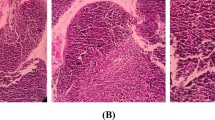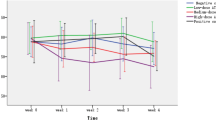Abstract
The present study was designed to evaluate the effect of sub-chronic doses of endosulfan on humoral and cell-mediated immune (CMI) responses in albino rats. Male albino rats were given a diet containing 5, 10 or 20 ppm endosulfan for 8–22 weeks and immunized with tetanus toxoid in Freund's complete adjuvant subcutaneously 20 days before terminating the exposure. The humoral immune response was studied by serum globulin level, immunoglobulin (IgM and IgG) concentration and antibody titre against tetanus toxoid. The CMI response was studied by leucocyte migration inhibition (LMI) and macrophage migration inhibition (MMI) factors. The antigen-induced increases in serum globulin fraction and immunoglobulin level were reduced at high doses of the endosulfan after 12 weeks of exposure. Antibody titre was significantly decreased in endosulfan-exposed rats at 10 and 20 ppm levels and a consistent trend was observed. Rats in the 10 and 20 ppm dose groups had significantly depressed LMI and MMI responses. Results obtained in this study revealed marked suppression of the humoral and CMI responses in rats administered with sub-chronic doses of endosulfan. Both cellular and humoral immune responses were decreased in a dose-time dependent pattern. Suppression of immune responses by endosulfan is clearly an important aspect of its toxicology.
Similar content being viewed by others
References
Banerjee BD (1984) Effect of Some common pesticides on immune system of experimental animals. Ph. D. Thesis, Aligarh Muslim University, India
Demeter J, Heyndrickx A, Timperman J, Lefevera M, Deeper J (1977) Toxicological analysis in a case of endosulfan suicide. Bull Environ Contam Toxicol 18: 110–114
Faith RE, Luster MI, Vos JG (1980) Effect on immuno-competence by chemicals of environmental concern. Rev Biochem Toxicol 2: 173–211
FAO/WHO (1975a) Endosulfan. In: 1974 Evaluations of some pesticides residues in food. Rome Food and Agriculture Organization of the United Nations
FAO/WHO (1975b) Data sheets on pesticides: endosulfan. Rome Food and Agriculture Organization of the United Nations
FAO/WHO (1983) Endosulfan. In: 1982 Evaluations of some pesticide residues in food. Rome Food and Agriculture Organization of the United Nations
Goldstein A (1964) Biostatistics, Macmillan Company, New York, pp 63–69
Herbert WJ (1979) Passive haemagglutination with special reference to the tanned cell techniques In Weir DM (ed) Handbook of experimental immunology. Blackwell Scientific Publication, London, p 20.1
Israeli R, Kristal N, Tiberin P (1969) Endosulfan poisoning a preliminary report on three cases. Zentrabl Arbeitsmed Arbeitsschutz 19: 1
Janah S, Hussain QZ, Chaudhuri SN (1970) Effect of hydrocortisone in immune cytokinetics. Part I —Effect of different doseschedules on 19S and 7S antibody forming cells in Jernś plaque Technique. Ind J Med Res 58: 1206–1216
Kazen C, Bloomer A, Welch R, Oudbier A, Price H (1974) Persistence of pesticides on the hands of some occupationally exposed people. Arch Environ Health 29: 315–318
Mancini G, Caronara AD, Heremans JE (1965) Immunochemical quantion of antigens by single radial immunodiffusion. Immunochem 2: 235–243
Street JC, Sharma RP (1975) Alteration of induced cellular and humoral immune responses by pesticides and chemicals of environmental concern: Quantitative studies of immuno-suppresion by DDT, aroclor 1254, carbaryl, carbofuron and methylparathion. Toxicol Appl Pharmacol 32: 587–602
Tiberin P, Kristal N, Israeli R (1970) EEG findings in poisoning by endosulfan. Electroencephalogr Clin Neurophysiol 28: 642–648
Vos JC (1977) Immune suppression as related to toxicology, CRC Critical Rev Toxicol 5: 67–101
Wassermann M, Wassermann D, Gershon Z, Zellermayer L (1969) Effects of organochlorine insecticides on body defense system. Ann NY Acad Sci 160: 393–401
Wassermann M, Wassermann D, Kedar E, Djuduvaherian M, Cucoss S (1972) Effects of dieldrin, gamma BHC on serum proteins and PBI. Bull Environ Contam Toxicol 8: 177–185
WHO (1984) Endosulfan, Environmental Health Criteria 40. World Health Organization, Geneva
Author information
Authors and Affiliations
Rights and permissions
About this article
Cite this article
Banerjee, B.D., Hussain, Q.Z. Effect of sub-chronic endosulfan exposure on humoral and cell-mediated immune responses in albino rats. Arch Toxicol 59, 279–284 (1986). https://doi.org/10.1007/BF00290551
Received:
Accepted:
Issue Date:
DOI: https://doi.org/10.1007/BF00290551




